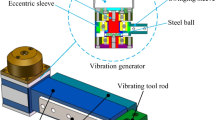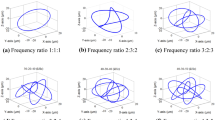Abstract
Vibration-assisted turning (VAT) is a technique to impose controlled external vibration on original cutting motion of turning process in order to improve part accuracy, surface quality, and tool life. In this study, the mechanics of orthogonal turning with low-frequency (less than 1000 Hz) vibration assistance is investigated. Finite element simulations are conducted to predict and compare the stresses, forces, and temperature between conventional turning (CT) and low-frequency vibration-assisted turning (LVAT). Turning experiments with vibration assistance achieved by electromagnetic actuator are conducted to validate the finite element (FE) model. The effect of vibration assistance on machining performance is quantitatively determined for three typical aerospace materials: Ti6Al4V, AISI 4340, and Al 2024 T351. It is found that LVAT is effective in reducing cutting forces, effective stresses, and cutting temperature. Compressive residual stresses are dominant in LVAT due to the added vibration. Tool wear and surface roughness in LVAT are also experimentally characterized and analyzed.
Similar content being viewed by others
References
Brehl DE, Dow TA (2008) Review of vibration-assisted machining. Precis Eng 32:153–172
Kumar MN, Kanmani Subbu S, Vamsi Krishna P, Venugopal A (2014) Vibration assisted conventional and advanced machining: a review. Procedia Eng 97:1577–1586
Thoe TB, Aspinwall DK, Wise MLH (1998) Review on ultrasonic machining. Int J Mach tool Manu 38(4):239–255
Skelton RC (1969) Effect of ultrasonic vibration on the turning process. Int J Mach Tool D R 9:363–374
Babitsky V, Kalashnikov A, Meadows A, Wijesundara AAH (2003) Ultrasonically assisted turning of aviation materials. J Mater Process Technol 132:157–167
Ding H, Ibrahim R, Cheng K, Chen S-J (2010) Experimental study on machinability improvement of hardened tool steel using two dimensional vibration-assisted micro-end-milling. Int J Mach Tools Manuf 50(12):1115–1118
Patil S, Joshi S, Tewari A, Joshi SS (2014) Modelling and simulation of effect of ultrasonic vibrations on machining of Ti6Al4V. Ultrasonics 54:694–705
Skelton RC (1968) Turning with an oscillating tool. Int J Mach Tool D R 8:239–259
Kim HS, Kim SI, Lee KI et al (2009) Development of a programmable vibration cutting tool for diamond turning of hardened mold steels. Int J Adv Manuf Technol 40:26–40
Adachi K, Yoshikawa A, Sakurai K (2004) A study on burr low frequency vibratory drilling. Mater Forum 28:178–183
Chern GL, Chang YC (2006) Using two-dimensional vibration cutting for micro-milling. Int J Mach Tools Manuf 46:659–666
.ABAQUS (2014), CAE user guide. Version 6.13
Ma J, Duong NH, Lei S (2014) Numerical investigation of the performance of microbump textured cutting tool in dry machining of AISI 1045 steel. J Manuf Process 19:194–204
Özel T, Zeren E (2005) A methodology to determine work material flow stress and tool-chip interfacial friction properties by using analysis of machining. J Manuf Sci Eng 128(1):119–129
Teng X, Wierzbicki T (2006) Evaluation of six fracture models in high velocity perforation. Eng Fract Mech 73:1653–1678
Johnson GR, Cook HW (1985) Fracture characteristics of three metals subjected to various strains, strain rates, temperatures and pressures. Eng Fract Mech 21:31–48
Yancheng Z, Outeiro JC, Mabrouki T (2015) On the selection of Johnson-Cook constitutive model parameters for Ti-6Al-4V using three types of numerical models of orthogonal cutting. Procedia CIRP 31:112–117
Henriksen EK (1951) Residual stress in machined surfaces. Trans ASME 73:69–76
Thiele JD, Melkote SN (2000) Effect of cutting-edge geometry and workpiece hardness on surface residual stresses in finish hard turning of AISI 52100 steel. J Manu Sci Eng 122:642–649
Schulze V, Zanger F (2011) Numerical analysis of the influence of Johnson-cook material parameters on the surface integrity of Ti-6Al-4V. Procedia Eng 19:306–311
Dahlman P, Gunnberg F, Jacobson M (2004) The influence of rake angle, cutting feed and cutting depth on residual stresses in hard turning. J Mater Process Technol 147:181–184
Ahmed N, Mitrofanov AV, Babitsky VI, Silberschmidt VV (2006) Analysis of material response to ultrasonic vibration loading in turning Inconel 718. Mater Sci Eng 424:318–325
.Bruker AXS (2009) LEPTO DIFFRAC plus LEPTOS User Manual 2009
He BB (2003) Introduction to two-dimensional X-ray diffraction. Powder Diffract 18(2):71–85
He BB, Preckwinkel U, Smith KL (1998) Advantages of using 2D detectors for residual stress measurements, advances in X-ray analysis, 47th Annual Denver X-ray Conference, Colorado Springs, USA
He BB, Preckwinkel U, Smith KL (1999) Fundamentals of two-dimensional X-ray diffraction (XRD2). Adv X-ray Anal 43:273–280
Özel T, Karpat Y, Srivastava A (2008) Hard turning with variable micro-geometry PcBN tools. CIRP Ann-Manuf Technol 57:73–76
.Gray GT, Chen SR, Wright W, Lopez MF (1994) Constitutive equations for annealed metals under compression at high strain rates and high temperatures. New Mex los Alamos Natl Lab 21–28.
Banerjee B (2007) The mechanical threshold stress model for various tempers of AISI 4340 steel. Int J Solids Struct 44:834–859
Arrazola PJ, Ozel T (2010) Investigations on the effects of friction modeling in finite element simulation of machining. Int J of Mech Sci 52:31–42
Asad M, Girardin F, Mabrouki T, Rigal JF (2008) Dry cutting study of an aluminium alloy (A2024-T351): a numerical and experimental approach. Int J Mater Form 1:499–502
Lesuer DR (2000) Experimental investigations of material models for TI-6Al-4V titanium and 2024-T3 aluminum. Off Aviation Res Washington:1–41
Daoud M, Chatelain JF, Bouzid A (2015) On the effect of Johnson Cook material constants to simulate Al2024-T3 machining using finite element modeling. Int J Adv Manuf Technol 81:1987–1997
Author information
Authors and Affiliations
Corresponding author
Rights and permissions
About this article
Cite this article
Maroju, N.K., Vamsi, K.P. & Xiaoliang, J. Investigations on feasibility of low-frequency vibration-assisted turning. Int J Adv Manuf Technol 91, 3775–3788 (2017). https://doi.org/10.1007/s00170-017-0034-6
Received:
Accepted:
Published:
Issue Date:
DOI: https://doi.org/10.1007/s00170-017-0034-6




